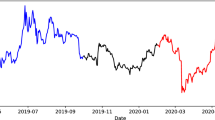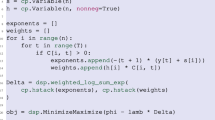Abstract.
This paper presents a new approach to interest rate dynamics. We consider the general family of arbitrage-free positive interest rate models, valid on all time horizons, in the case of a discount bond system driven by a Brownian motion of one or more dimensions. We show that the space of such models admits a canonical mapping to the space of square-integrable Wiener functionals. This is achieved by means of a conditional variance representation for the state price density. The Wiener chaos expansion technique is then used to formulate a systematic analysis of the structure and classification of interest rate models. We show that the specification of a first-chaos model is equivalent to the specification of an admissible initial yield curve. A comprehensive development of the second-chaos interest rate theory is presented in the case of a single Brownian factor, and we show that there is a natural methodology for calibrating the model to at-the-money-forward caplet prices. The factorisable second-chaos models are particularly tractable, and lead to closed-form expressions for options on bonds and for swaptions. In conclusion we outline a general “international” model for interest rates and foreign exchange, for which each currency admits an associated family of discount bonds, and show that the entire system can be generated by a vector of Wiener functionals.
Similar content being viewed by others
Author information
Authors and Affiliations
Corresponding author
Additional information
Received: March 2004,
Mathematics Subject Classification (2000):
91B28, 91B30, 91B50, 60H07
JEL Classification:
E43
We are grateful to J. Boland, D. Brody, P. Carr, M. Davis, F. Delbaen, D. Filipović, R. Jarrow, M. Grasselli, P. Hunt, T. Hurd, D. Madan, P. Malliavin, H. Rasmussen and M. Zervos for stimulating discussions. We thank D. Brody, M. Grasselli, T. Hurd and M. Zervos, in particular, for suggesting a number of improvements in the arguments presented here. We are grateful for helpful comments by participants at the Frontiéres en Finance seminar, Paris, May 2002, the Mathematics in Finance conference, Kruger Park, RSA, August 2002, the Imperial College finance seminar, February 2003, the 13th annual Derivative Securities Conference, New York, April 2003, the Analysis of Random Markets Workshop, Banach Center, Warsaw, October 2003 and the Quantitative Methods in Finance Conference, Sydney, December 2003, where this work was presented. LPH acknowledges the hospitality of the Institute for Advanced Study, Princeton, where part of this work was carried out. AR acknowledges financial support from the Department of Mathematics, King’s College London.
Rights and permissions
About this article
Cite this article
Hughston, L.P., Rafailidis, A. A chaotic approach to interest rate modelling. Finance and Stochastics 9, 43–65 (2005). https://doi.org/10.1007/s00780-004-0135-6
Issue Date:
DOI: https://doi.org/10.1007/s00780-004-0135-6




